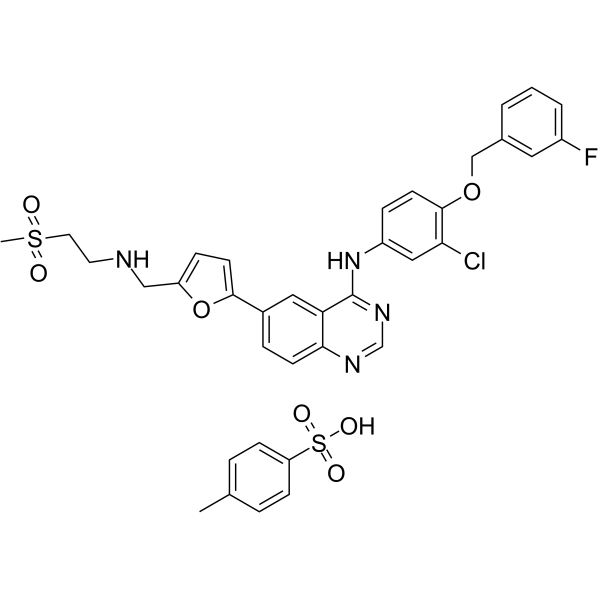Lapatinib (4-Methylbenzenesulfonate)
Modify Date: 2025-08-26 16:28:53

Lapatinib (4-Methylbenzenesulfonate) structure
|
Common Name | Lapatinib (4-Methylbenzenesulfonate) | ||
|---|---|---|---|---|
| CAS Number | 1187538-35-7 | Molecular Weight | 753.259 | |
| Density | N/A | Boiling Point | N/A | |
| Molecular Formula | C36H34ClFN4O7S2 | Melting Point | N/A | |
| MSDS | N/A | Flash Point | N/A | |
Use of Lapatinib (4-Methylbenzenesulfonate)Lapatinib (GW572016) tosylate is a potent, orally active inhibitor of the ErbB-2 and EGFR tyrosine kinase domains with IC50 values against purified EGFR and ErbB-2 of 10.2 and 9.8 nM, respectively[1]. |
| Name | N-{3-Chloro-4-[(3-fluorobenzyl)oxy]phenyl}-6-[5-({[2-(methylsulfonyl)ethyl]amino}methyl)-2-furyl]-4-quinazolinamine 4-methylbenzenesulfonate (1:1) |
|---|---|
| Synonym | More Synonyms |
| Description | Lapatinib (GW572016) tosylate is a potent, orally active inhibitor of the ErbB-2 and EGFR tyrosine kinase domains with IC50 values against purified EGFR and ErbB-2 of 10.2 and 9.8 nM, respectively[1]. |
|---|---|
| Related Catalog | |
| Target |
EGFR:10.2 nM (IC50) ErbB2:9.8 nM (IC50) |
| In Vitro | Lapatinib (GW2016; 0.03-10 µM; 6 hours; BT474 and HN5 cells) tosylate treatment inhibits receptor autophosphorylation of EGFR and ErbB-2 in a dose-responsive manner. Phosphorylation of serine 473 of AKT was inhibited by GW2016 in a dose-dependent manner[1]. Lapatinib (GW2016; 72 hours; HN5, A-43, BT474, N87, and CaLu-3 cells) tosylate treatment has a selective inhibition of the proliferation of human tumor cell lines[1]. Lapatinib (GW2016; 1-10 µM; 72 hours; HN5 cells) treatment results in induces G1 arrest[1]. Cell Proliferation Assay[1] Cell Line: HN5, A-43, BT474, N87, and CaLu-3 cells Concentration: 1 nM-100 µM Incubation Time: 72 hours Result: Inhibited the growth of tumor cells overexpressing EGFR or ErbB-2. Cell Cycle Analysis[1] Cell Line: HN5 cells Concentration: 1 µM, or 10 µM Incubation Time: 72 hours Result: Resulted in induction of G1 arrest. Western Blot Analysis[1] Cell Line: BT474 and HN5 cells Concentration: 0.03 µM, 0.1 µM, 0.3 µM, 1 µM, 3 µM, or 10 µM Incubation Time: 6 hours Result: Inhibited receptor autophosphorylation of EGFR and ErbB-2 in a dose-responsive manner. Phosphorylation of serine 473 of AKT was also inhibited in a dose-dependent manner. |
| In Vivo | Lapatinib (GW2016; 30-100 mg/kg; oral administration; twice daily; for 21 days; CD-1 nude female mice) tosylate treatment inhibits tumor xenograft growth of the HN5 cells in a dose-responsive manner at 30 and 100 mg/kg, with complete inhibition of tumor growth at the higher dose[1]. Animal Model: CD-1 nude female mice (4-6 weeks old) with HN5 cells[1] Dosage: 30 mg/kg, 100 mg/kg Administration: Oral administration; twice daily; for 21 days Result: Inhibited tumor xenograft growth of the HN5 cells in a dose-responsive manner. |
| References |
| Molecular Formula | C36H34ClFN4O7S2 |
|---|---|
| Molecular Weight | 753.259 |
| Exact Mass | 752.154175 |
| N-{3-Chloro-4-[(3-fluorobenzyl)oxy]phenyl}-6-[5-({[2-(methylsulfonyl)ethyl]amino}methyl)-2-furyl]-4-quinazolinamine 4-methylbenzenesulfonate (1:1) |
| 4-Quinazolinamine, N-[3-chloro-4-[(3-fluorophenyl)methoxy]phenyl]-6-[5-[[[2-(methylsulfonyl)ethyl]amino]methyl]-2-furanyl]-, 4-methylbenzenesulfonate (1:1) |